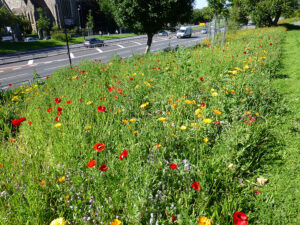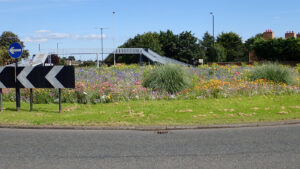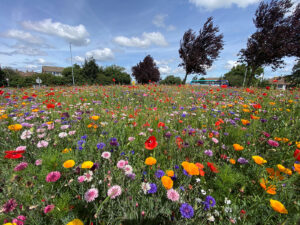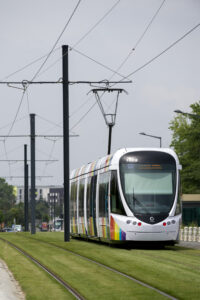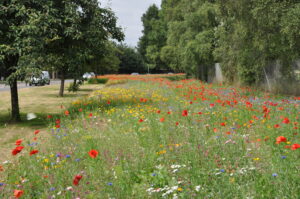The benefits of ‘Urban Greening’ schemes
Related Articles
Jayne Leyland from Origin Amenity Solutions explains how the company’s customers are enjoying significant environmental benefits and cost savings as a result of ‘Urban Greening’ schemes.
Green spaces such as parks, playing fields and landscaping around city-centre buildings or green roofs are increasingly recognised as valuable assets and play an important role in our daily lives.
They deliver many health, social and environmental benefits. Green spaces that are accessible, attractive, well maintained and with space for socialisation increase opportunity and motivation for people to use them.
Roadside verges and roundabouts, unlike amenity green spaces enjoyed for leisure pursuits, are deemed non-productive land with little or no amenity value. However, the visual, environmental, and economic impact of their management continues to attract a high level of awareness and scrutiny.
Smart savings
Mowing expansive areas of grassland is a costly exercise. Within every local authority millions of square metres of amenity grassland are mown as frequently as 12 times per year. Budgetary pressures and rewilding to support biodiversity has hugely reduced both the frequency and extent of mowing in many regions.
However where grass is still required, for example parkland, there is still a need to reduce the carbon footprint and maintenance costs.
Advances in amenity grass breeding and research continues to yield effective results. Slower re-growth, recovery from drought and increased carbon sequestration provide environmental benefits alongside maintenance savings, such as a reduction in the associated costs and mitigating the impact of mowing which contribute to the carbon footprint.
Greening infrastructure
Origin Amenity Solutions invests heavily in grass technology and innovation. Together with grass breeder Top Green, our Carbon4Grass range of grass seed was developed.
Over the last two decades the differences between grass cultivars in their capacity to store and sequester carbon within the leaves, roots and soil profile when managed under the same environmental conditions has been monitored and measured. The data and knowledge gleaned led to the creation of a range of grass seed mixes that combined comparatively increased levels of carbon sequestration with desirable amenity characteristics for a range of amenity applications – the Carbon4Grass range.
An example is the Low Maintenance grass seed mix which is ideal for low maintenance lawns and landscaping, roadside verges, roundabouts and embankments. The mix includes Angelina which is the slowest re-growth cultivar in Turfgrass Seed 2023 with a score of 8.2, helping reduce mowing frequency and Creepstar creeping perennial ryegrass for fast establishment to help out-compete weed ingression and improve recovery from environmental stress. The inclusion of hard and sheep’s fescues for added drought tolerance and density completes this mix. The combination of cultivars will produce a fast establishing, hard wearing, attractive sward with excellent colour and recovery from drought. The benefits of reduced mowing and increased carbon sequestration make Low Maintenance the fundamental grass seed choice for ‘greening’ infrastructure projects and mitigating the carbon footprint.
An increase in biodiversity and a decrease in costs
Mowing grass verge strips is an essential operation for traffic safety, ensuring site lines are unimpeded and excessive growth does not obstruct the carriageway. Verges also play an important role as a buffer zone between the road and other structural landscape elements, forming wildlife corridors and acting as soakaways for rainwater and floodwater when roadside drains become blocked.
They soak up carbon, pollutants and have a cooling influence, helping regulate temperatures in urban environments. The majority of roadside verge is now maintained with just a single cut of 1.2 metre strip adjacent roadside per annum; however, long-established verges historically seeded with agricultural grasses and invaded by tall flowering ‘weeds’ present their own challenges, especially for traffic convergences.
Many councils are replacing overgrown or sparse grass verges with urban flower mixes, commonly referred to as wildflowers, transforming these spaces into a biodiverse-rich alternative wildlife haven. Euroflor is Origin Amenity Solutions’ urban flower mix range producing spectacular, colourful flowering displays and enhancing biodiversity, attracting a host of pollinating insects.
For example, Euroflor Boulevard 100% flower seed is a low growing, attractive mix of 18 native and naturalised, predominantly perennial species, which means there is no requirement for annual sowing and only minimal maintenance with reduced mowing as only one cut per year is needed in late autumn. Sites sown with this beautiful mixture offer a stunning display, enhanced habitat biodiversity, as well as significant maintenance cost savings for roadside verge cutting and management.
Euroflor Boulevard is a social, economic and environmental win and is the popular choice for renewing and creating local authority roadside verges, splays and roundabouts, driveways, parkland borders and urban infrastructure settings.
For further information on Carbon4Grass or Euroflor Seed contact Origin Amenity Solutions om 0800 424 919

